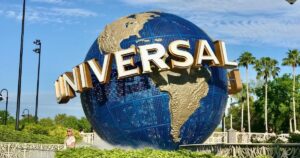
Universal Studios Hollywood is a film studio and theme park in the San Fernando Valley area of Los Angeles County, California. About 70% of the studio lies within the unincorporated county island known as Universal City while the rest lies within the city limits of Los Angeles, California. It is one of the oldest and most famous Hollywood film studios still in use. Its official marketing headline is “The Entertainment Capital of LA”. It was initially created to offer tours of the real Universal Studios sets and is the first of many full-fledged Universal Studios Theme Parks located across the world.
Outside the theme park, a new, all-digital facility near the Universal Pictures backlot was built in an effort to merge all of NBCUniversal’s West Coast operations into one area. As a result, the current home for KNBC, KVEA and NBC News with Noticias Telemundo Los Angeles Bureaus with new digital facility is on the Universal lot formerly occupied by Technicolor SA. Universal City includes hotels Universal Hilton & Towers, the Sheraton Universal Hotel, and Universal CityWalk, which offers a collection of shops, restaurants, an 18-screen Universal Cinema and a seven-story IMAX theater. In 2017, the park hosted 9.056 million guests, ranking it 15th in the world and 9th among North American parks.
The first studio tour
In 1914, German American immigrant Carl Laemmle bought the Taylor Ranch in the San Fernando Valley and founded Universal City as a gigantic studio with a zoo, its own police and mayor and native Americans living on the premises. On March 14, 1915, Laemmle opened Universal Studios in a two-day grand opening event with 10,000 attendees.He later invited the general public to see all the action for an admission fee of just five cents, which also included a boxed lunch with chicken. There was also a chance to buy fresh produce, since then-rural Universal City was still in part a working farm. This original tour was discontinued around 1930, due to the advent of sound films and the stages being not sufficiently soundproofed.
Backlot fires
Universal Studios Hollywood’s backlot has been damaged by fire nine times throughout its history. The first was in 1932, when embers from a nearby brush fire were blown toward the back lot, causing four movie sets to be destroyed and resulting in over $100,000 damage.Seventeen years later, in 1949, another brush fire caused the complete destruction of one building and damage to two others. In 1957, the New York street film studio set was destroyed by an arson fire, causing a half-million dollars in damage. Ten years later, in 1967, twice as much damage was done when the Little Europe area and part of Spartacus Square was destroyed. It also destroyed the European, Denver and Laramie street sets. In 1987, the remaining portion of Spartacus Square was destroyed along with street sets and other buildings.
Park history
Shortly after Music Corporation of America (MCA) took over Universal Pictures in 1962, accountants suggested a new tour in the studio commissary would increase profits. On July 15, 1964, the modern tour was established to include a series of dressing room walk-throughs, peeks at actual production, and later, staged events. This grew over the years into a full-blown theme park. The narrated tram tour (formerly “Glamor Trams” still runs through the studio’s active backlot, but the staged events, stunt demonstrations and high-tech rides overshadow the motion-picture production that once lured fans to Universal Studios Hollywood.
The Flintstones Show opened, replacing the Star Trek Adventure. In 1991, E.T. Adventure opened as the park’s first “dark ride,” an industry term for an attraction that uses ride vehicles to take passengers through an indoor show building. Around the same time, sister park Universal Studios Florida opened, which had its own, similar E.T. attraction. The Florida version was more of a conventional theme park and paved the way for the Hollywood park’s evolution. In 1993, Back to the Future: The Ride opened, replacing Battle of Galactica. In 1996, Jurassic Park: The Ride opened. In 1997, two shows were replaced: The Land Before Time show replaced Rocky and Bullwinkle Live; and Totally Nickelodeon replaced the Flintstones Show. Just one year after it opened, the Land Before Time show was replaced with Coke Soak. In 1999, T2-3D: Battle Across Time and a Chicken Run Walkthrough opened on the upper lot. Additionally, Beetlejuice’s Rock and Roll Graveyard Revue was closed.

Recent Comments